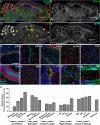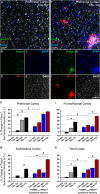Infection Augments Expression of Mechanosensing Piezo1 Channels in Amyloid Plaque-Reactive Astrocytes
- PMID: 30405400
- PMCID: PMC6204357
- DOI: 10.3389/fnagi.2018.00332
Infection Augments Expression of Mechanosensing Piezo1 Channels in Amyloid Plaque-Reactive Astrocytes
Abstract
A defining pathophysiological hallmark of Alzheimer's disease (AD) is the amyloid plaque; an extracellular deposit of aggregated fibrillar Aβ1-42 peptides. Amyloid plaques are hard, brittle structures scattered throughout the hippocampus and cerebral cortex and are thought to cause hyperphosphorylation of tau, neurofibrillary tangles, and progressive neurodegeneration. Reactive astrocytes and microglia envelop the exterior of amyloid plaques and infiltrate their inner core. Glia are highly mechanosensitive cells and can almost certainly sense the mismatch between the normally soft mechanical environment of the brain and very stiff amyloid plaques via mechanosensing ion channels. Piezo1, a non-selective cation channel, can translate extracellular mechanical forces to intracellular molecular signaling cascades through a process known as mechanotransduction. Here, we utilized an aging transgenic rat model of AD (TgF344-AD) to study expression of mechanosensing Piezo1 ion channels in amyloid plaque-reactive astrocytes. We found that Piezo1 is upregulated with age in the hippocampus and cortex of 18-month old wild-type rats. However, more striking increases in Piezo1 were measured in the hippocampus of TgF344-AD rats compared to age-matched wild-type controls. Interestingly, repeated urinary tract infections with Escherichia coli bacteria, a common comorbidity in elderly people with dementia, caused further elevations in Piezo1 channel expression in the hippocampus and cortex of TgF344-AD rats. Taken together, we report that aging and peripheral infection augment amyloid plaque-induced upregulation of mechanoresponsive ion channels, such as Piezo1, in astrocytes. Further research is required to investigate the role of astrocytic Piezo1 in the Alzheimer's brain, whether modulating channel opening will protect or exacerbate the disease state, and most importantly, if Piezo1 could prove to be a novel drug target for age-related dementia.
Keywords: Alzheimer’s disease; Piezo1; TgF344-AD rats; amyloid plaques; astrocytes; dentate gyrus; mechanosensitive ion channel; urinary tract infection.
Figures







Similar articles
-
Piezo1 regulates calcium oscillations and cytokine release from astrocytes.Glia. 2020 Jan;68(1):145-160. doi: 10.1002/glia.23709. Epub 2019 Aug 21. Glia. 2020. PMID: 31433095
-
Microglial Piezo1 senses Aβ fibril stiffness to restrict Alzheimer's disease.Neuron. 2023 Jan 4;111(1):15-29.e8. doi: 10.1016/j.neuron.2022.10.021. Epub 2022 Nov 10. Neuron. 2023. PMID: 36368316
-
Fatty acids as biomodulators of Piezo1 mediated glial mechanosensitivity in Alzheimer's disease.Life Sci. 2022 May 15;297:120470. doi: 10.1016/j.lfs.2022.120470. Epub 2022 Mar 10. Life Sci. 2022. PMID: 35283177 Review.
-
Quantification and correlation of amyloid-β plaque load, glial activation, GABAergic interneuron numbers, and cognitive decline in the young TgF344-AD rat model of Alzheimer's disease.Front Aging Neurosci. 2025 Feb 12;17:1542229. doi: 10.3389/fnagi.2025.1542229. eCollection 2025. Front Aging Neurosci. 2025. PMID: 40013092 Free PMC article.
-
Microglial Piezo1 mechanosensitive channel as a therapeutic target in Alzheimer's disease.Front Cell Neurosci. 2024 Jun 18;18:1423410. doi: 10.3389/fncel.2024.1423410. eCollection 2024. Front Cell Neurosci. 2024. PMID: 38957539 Free PMC article. Review.
Cited by
-
Lateral Piezoelectricity of Alzheimer's Aβ Aggregates.Adv Sci (Weinh). 2024 Oct;11(39):e2406678. doi: 10.1002/advs.202406678. Epub 2024 Aug 19. Adv Sci (Weinh). 2024. PMID: 39159132 Free PMC article.
-
The mechanosensitive ion channel Piezo1 modulates the migration and immune response of microglia.iScience. 2023 Jan 16;26(2):105993. doi: 10.1016/j.isci.2023.105993. eCollection 2023 Feb 17. iScience. 2023. PMID: 36798430 Free PMC article.
-
Roles of Piezo1 in chronic inflammatory diseases and prospects for drug treatment (Review).Mol Med Rep. 2025 Jul;32(1):200. doi: 10.3892/mmr.2025.13565. Epub 2025 May 16. Mol Med Rep. 2025. PMID: 40376999 Free PMC article. Review.
-
A Cation Channel Protects the Stretched Lung.Am J Respir Cell Mol Biol. 2020 Feb;62(2):128-129. doi: 10.1165/rcmb.2019-0292ED. Am J Respir Cell Mol Biol. 2020. PMID: 31469582 Free PMC article. No abstract available.
-
Piezo1 in microglial cells: Implications for neuroinflammation and tumorigenesis.Channels (Austin). 2025 Dec;19(1):2492161. doi: 10.1080/19336950.2025.2492161. Epub 2025 Apr 13. Channels (Austin). 2025. PMID: 40223276 Free PMC article. Review.
References
-
- Bavi N., Nikolaev Y. A., Bavi O., Ridone P., Martinac A. D., Nakayama Y., et al. (2017). “Principles of mechanosensing at membrane interface,” in The Biophysics of Cell Membranes, 19 Edn, eds Epand R. M., Ruysschaert J.-M. (Berlin: Springer Series in Biophysics Springer; ), 85–119. 10.1007/978-981-10-6244-5_4 - DOI
Grants and funding
LinkOut - more resources
Full Text Sources
Other Literature Sources

